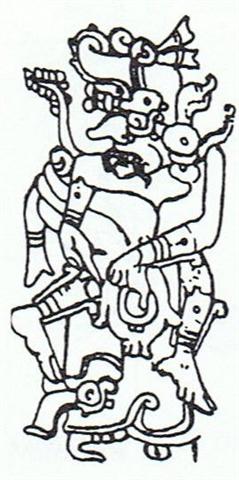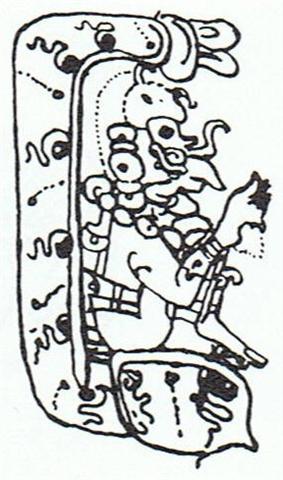1 The primary purpose of scrutinizing Ga3-18 was to see whether also the 5th Tahitian star pillar could be located at its expected position in the G text (at day 143 = glyph number 143):
It served the important function of reinforcing my interpretation of the structure of side a as related to the positions of eminent stars (although it by no means can be considered as certain that these star pillars really are there in the text and not only in my imaginative mind). We can leave the discussion about the 10th Tahitian star pillar (Polaris, Ana-nia, a 'pillar to fish by') to some other time - it is a special case because it ought to be on side b. Let us instead go on and talk about Toliman - could there be other star pillars on side a than those in the Tahitian list?
The red and yellow downy feathers of Ta'aroa - which easily will fly in the air when there is wind - are like all small things corresponding to 'children' (hua). Later they will grow into tall trees, such which can house fire (cfr at Tapa Mea): ... All the forests then caught fire, the land everywhere was alight, and Maui came very near to death. Then he called on his ancestor Tawhiri matea and all his offspring, to send down rain. 'Let water be given to quench this fire!' he cried, and spoke the appropriate chants. Great clouds appeared, and Tawhiri sent down first the small rain, and then the lasting rain, and everything was drenched, and the flames went out. Even Mahuika herself almost perished before she could reach her place of shelter, and her shrieks were as loud as those of Maui when he was scorched. The waters rose all around her, and in this way Mahuika was deprived of her former power. But fire was saved for the world. When the waters reached her tikitiki, or the topknot of her head, the last seeds of fire fled from it to the rata, the hinau, the kahikatea, the rimu, and certain other trees. These trees would not admit them, and so they went to the mahoe, the totara, the patete, the pukatea, and the kaikomako, where they were cherished. These are the trees from whose dry wood fire can be obtained by friction. The others are of no use for this purpose ... 28 days beyond Toliman comes Rehua and the heat of summer. If my 'star pillar structure' should work also for non-Tahitian pillars, then there ought to be a correspondence between the hanau (birth) glyph type in the G text and Toliman - which star then could be alluded to in Ga8-18:
Counted from Gb6-26 there are 64 + 222 = 286 glyphs (days) - while Rehua is located in position 186 (= 250 - 64) on side a. At Ga8-19 we can count 9 * 9 * 9 = 729 and the nearly vertical object in the center maybe should be compared with the left sign in Ga4-7:
If side a should not only contain the positions of star pillars counted from 'the woman in chains' (Rogo in Gb6-26) but also describe the main events up to high summer north of the equator - with the day numbers equal to the number of glyphs from Gb8-30 - then spring equinox could be at Ga4-5 and the end of the 1st quarter at Ga4-7. This, however, necessitates counting the days from winter solstice also north of the equator (numbers within parentheses below):
Henua in Ga4-3 at number 87 coincides with the day number for spring equinox counted from winter solstice south of the equator, but I guess it instead refers to the position immediately after 64 + 86 = 150. I have evidence from the Tahua text - though much too long to describe here - which seems to indicate some kind of connection between number 228 and 'birth'. There are 230 glyphs on side a of G and Metoro used the word heu just before what could be a glyph announcing the arrival of autumn (nuku):
At Aa2-28 he said i areheu which possibly could mean 'to dig out the offspring':
'Earth' (henua) inhabits (noho) the sky (Aa2-31) and in the following glyph Metoro mentioned 'fruit' (hua), maybe because he saw the little chicken with only one wing (kara etahi) in Aa2-33. There is a triplet of hanau glyphs where side a of G is ending and side b beginning:
The head is gone in the day of Saturn and also in the day of Jupiter, but not in the day of Venus (the 'star of birth'). The arms held high in Gb1-2 are not pointed, which probably is a sign of 'the back side'. Instead of a head there is an areheu sign in Ga8-18, while in Gb1-2 the corresponding complex sign contains Y at the bottom: ... In the upper part of the façade, as a pendant to the calabash on the right which represents the sun, it is a drawing of the moon, either full or as a crescent. This is a reminder, on the left-hand side, of the celestial regions. In the remaining space on the wall there are various ritual objects and animals in no particular order: the priest's forked staff, which is a symbol of both masculinity and femininity; the shaft itself, which is breast-high, is male, the female part is the fork in which the priest rests his forefinger, itself a symbol of the male ... If Toliman should be considered as a star which announces the birth of the next 'side', then hanau is understandable. We can use the Taranaki roof as an explanation:
Beyond the triangular apex, where the serpent king is loosing his head in order to form the egg ('fruit') of the next development, there is a vacant space ('interregnum') followed by a childish face halfway down to the end of the side. Then comes water with 5 immersed figures and a male cat in the middle. We could expect the beginning of side b (probably corresponding to the back side of the Taranaki roof) to exhibit signs of 'fruits which are buried in the ground' (they cannot be seen). The Rain God is down in the cavern of Mother Earth beyond midsummer:
... The end of the first part of the sequence is indicated by a reversal, the Rain God up in the 'tree' is looking back. By climbing the tree the Rain God has reached summer solstice, we can conclude. At the root of the tree even the face of the 'monster' is looking back ... |
||||||||||||||||||||||||||||||||||||||||||||||||||||||||||||||||||||||||||||||||||||||||||||||||||||||||||||||||||||||||||||||||||||||||||||||||||||||||||||||||||||||||||||||




















